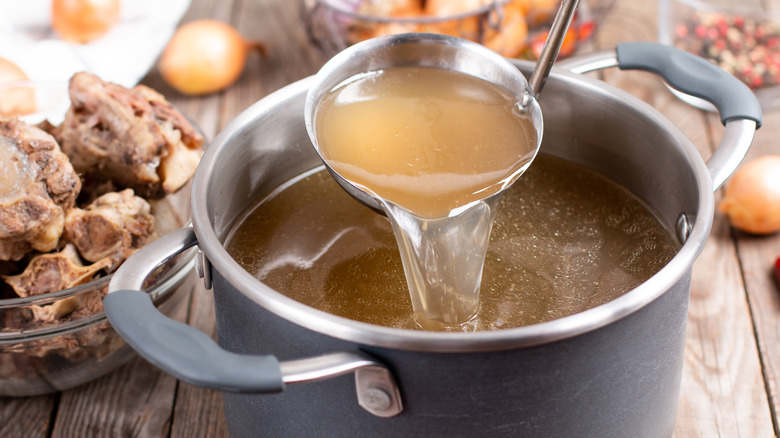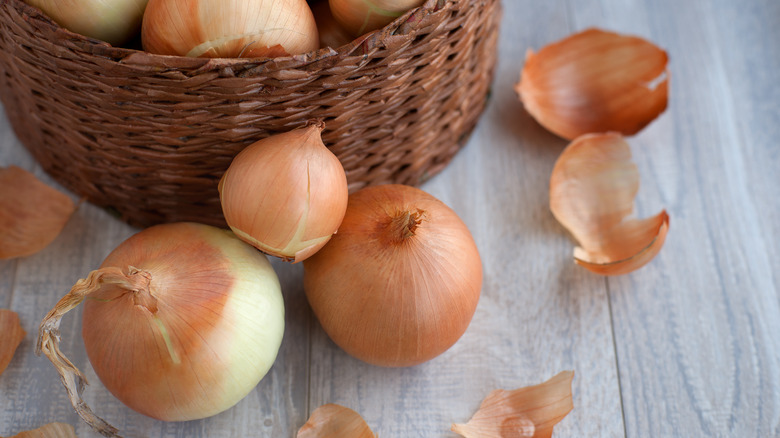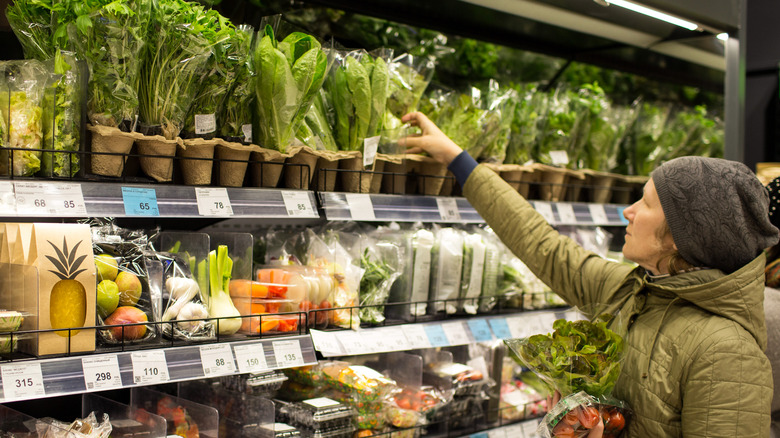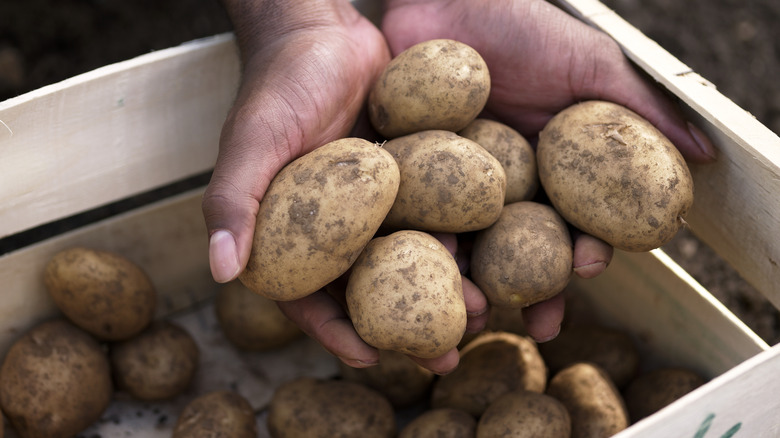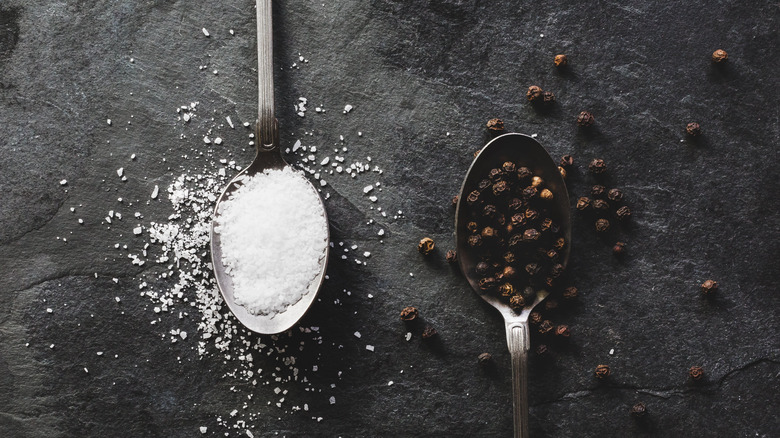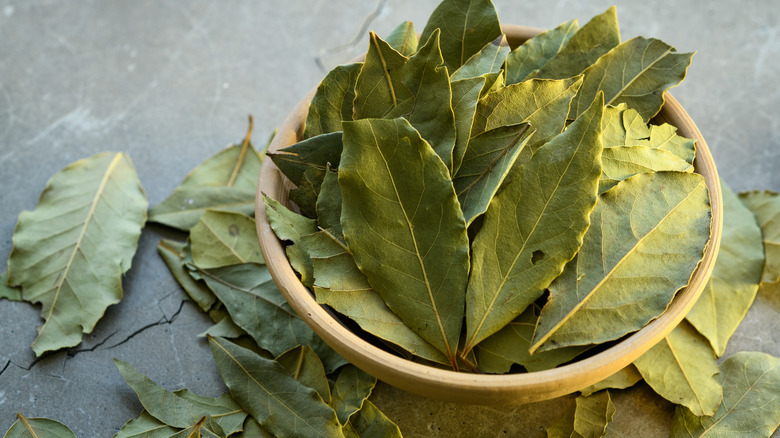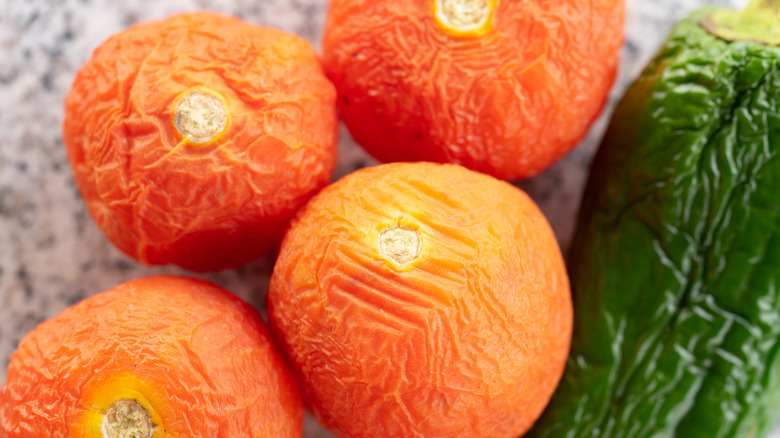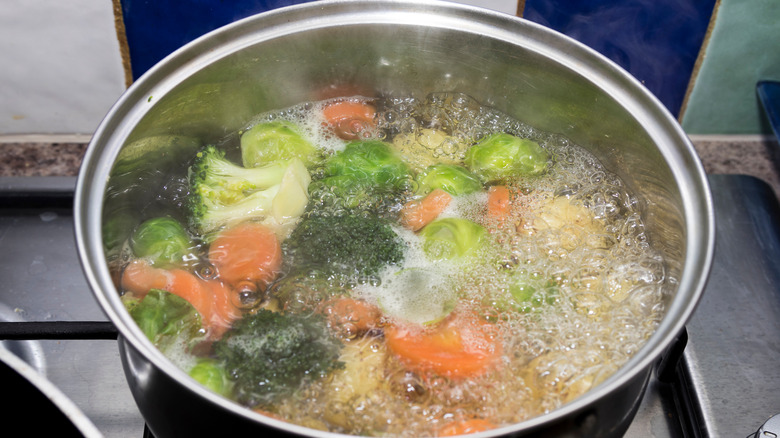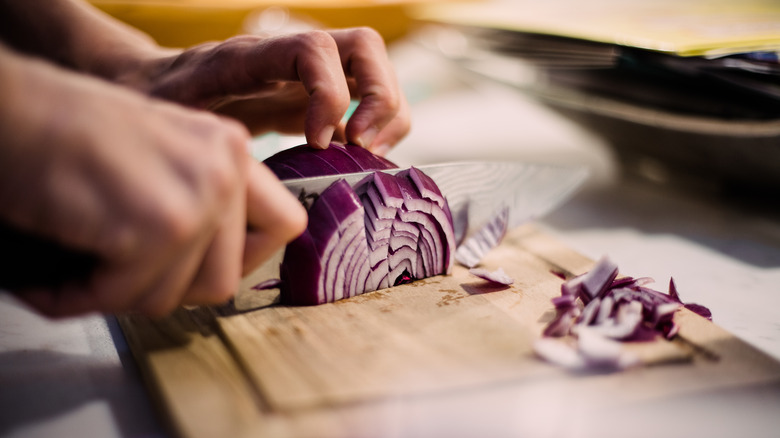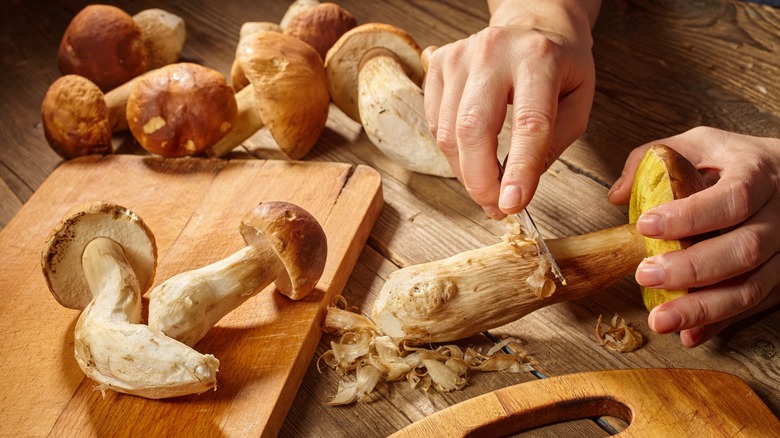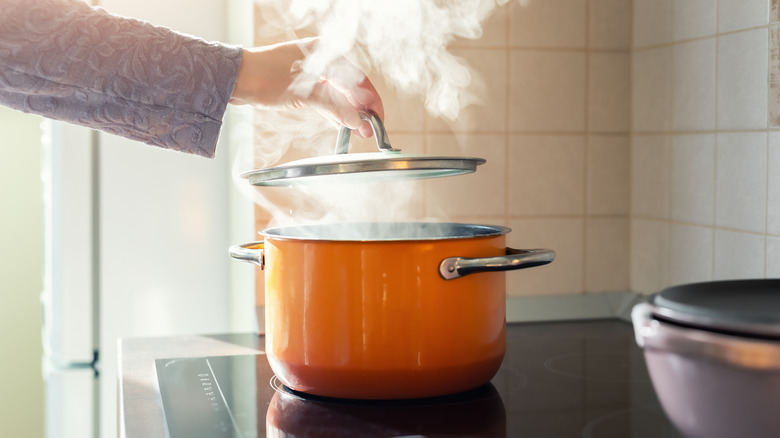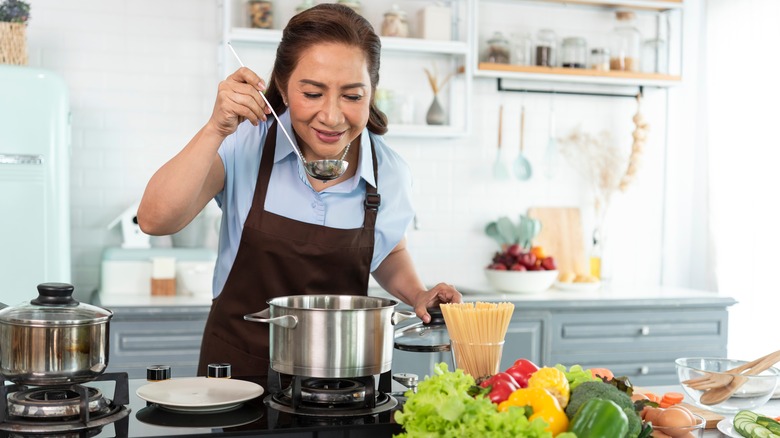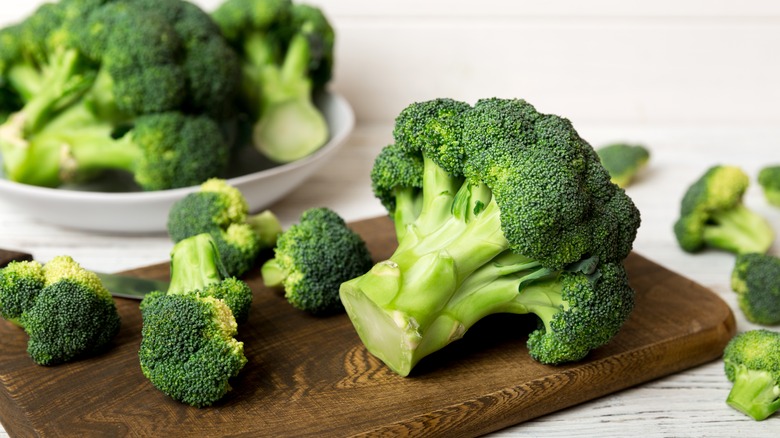14 Mistakes Everyone Makes With Homemade Vegetable Stock
Whether you're looking to reduce your food waste, save money on produce, or simply get more creative in the kitchen, making homemade vegetable stock is the answer. Although store-bought stock may seem like the easier option, commercial stocks are loaded with sodium and artificial flavors, according to MasterClass. Homemade stocks, on the other hand, can be tailored to your flavor preference, and may be used as the base in soups, in place of water, and in your favorite homemade sauces (via The Washington Post).
Not only is homemade vegetable stock relatively easy to make, it's also more nutrient-dense and flavorful than any store-bought options, according to Ripley Farm. By making your own stock, you have control over all the ingredients, as well as the amount of salt you're adding to your diet.
Even though making stock is relatively easy with very few steps and minimal ingredients, we've rounded up a list of common mistakes to avoid when making your homemade vegetable stock to give you the most flavorful outcome.
Throwing out onion and garlic skins
Although most people are in the habit of throwing out their onion and garlic skins after peeling them, Good Housekeeping reported that the flaky exterior of an onion or garlic peel is useful in vegetable stock, soups, dyed eggs, and even dying clothes, so don't toss them out with the compost. Not only will you be reducing your kitchen waste, you'll also be adding a golden color and subtle flavor to your homemade vegetable stock by hanging onto garlic and onion peels.
According to Farmers' Almanac, onion and garlic skins are also loaded with antioxidants and anti-inflammatory properties, as well as loads of vitamins A, C, and E. The best way to extract these nutrients without compromising them is to wash the garlic and onion thoroughly before throwing it in the stock — or into a freezer bag to use later. You'll also want to strain your stock thoroughly before using it in soup or storing it in a jar. The skins are tough enough that they will not disintegrate and overpower the stock.
Excluding herbs
Although most of us think of herbs as the dried seasoning jars in our spice cabinet, fresh herbs are so much more than just flavor boosters to your homemade vegetable stock. Although fresh herbs don't last as long as their dry counterparts, it's easy to toss them in your freezer bag with other vegetable scraps you're saving to make stock, according to The Washington Post.
Leafy herbs, such as parsley, sage, oregano, rosemary, and basil, not only enhance the flavor of your stock, but the nutritional value too. According to Michigan State University, herbs possess similar nutritional compounds as those found in leafy greens. They can also help fight off long-term illness like cardiovascular disease and diabetes while boosting the immune system. In fact, half a cup of parsley, a powerhouse herb, can provide the recommended daily intake of vitamins K and A.
Adding a half cup of herbs to your stock will help you meet your recommended daily intake of essential vitamins and minerals, and will help you tailor your stock to taste. For example, if you're adding your homemade vegetable stock to an Asian-inspired dish, you may want to incorporate more basil or cilantro. Try adding a pinch of saffron for a uniquely floral flavor or a pinch of star anise to spice up your stock.
Using too many starchy vegetables
The Washington Post deems carrots a necessary component to the base of any good vegetable stock, but the publication also points out that carrots, like many other types of root vegetables, contain high amounts of starch, which help to thicken stock but should be used in moderation. Using too many carrots or other root vegetables, such as parsnips and onions, may cause the stock to become thick and cloudy.
A well-balanced stock should not appear too cloudy or dense, as its main role in cooking is to use it as a liquid base for soup or starchy sides like risotto, according to MasterClass. Although it's fun to play around with different types of vegetables when making homemade stock, other starchy options to avoid include potatoes and the flesh of both winter squash and zucchini.
If you accidentally added too many starchy vegetables to your stock, there's still time to fix it. According to Better Homes & Gardens, clarifying stock can be done in a few easy steps. The first step is to strain it one or more times through a cloth strainer to catch any particles that are affecting clarity.
Using too much or too little salt and pepper
One of the goals in making your own vegetable stock should be eliminating unnecessary ingredients found in store-bought options, as well as reducing your sodium intake, as most packaged foods are loaded with salt (via MasterClass). While it's generally recommended to add salt and pepper to taste, there are ways to go about it so you're not over or under seasoning your stock.
Adding salt to the stock during its initial cooking stages is the best time to season it, as it gives you the most control and best outcome when it comes to the salt or pepper flavor. Waiting to salt until you're using it in a recipe like risotto or soup may not lend the richest flavor as it would if it were originally salted and seasoned.
When it comes to pepper, it's also recommended you season your vegetable stock to taste. You don't want it to be overpowered by pepper, but you do want to give it a little kick. The best way to accomplish this is by using whole peppercorns rather than ground pepper. To know if you've hit your flavor profile with salt and pepper, taste it as it cooks. Homestead and Chill recommends starting with two teaspoons of salt for every four quarts of liquid.
Leaving out bay leaves
If you picked up a bay leaf in the store without knowing what it was, you probably wouldn't be overly impressed by its rugged shape and texture, which is why you may make the mistake of leaving it out of your homemade vegetable stock. Once you've added this unique herb to sauces, soups and chowders, or risotto, you'll realized that the flavor profile will take any savory dish to the next level, as noted by LearntoCook.com.
According to a Reddit user, one way to truly know how important bay leaves may be to a recipe is to do a side-by-side taste test using rice. Add bay leaves to one portion while omitting them from another, and you'll immediately taste the difference, giving you an overall better understanding of how bay leaves truly elevate the aroma and taste of your food. Another Reddit user recommends using fresh bay leaves, rather than ones that have started to brown, as they release the most intense flavor when fresh.
Overlooking overly ripe tomatoes
Next time you're looking at limp produce in your produce drawer or soft tomatoes on the countertop, don't just toss them in the trash or compost without giving them a second chance. Homemade vegetable stock is a great way to reduce your food waste while saving money and extending the life of your produce, particularly when it comes to tomatoes.
According to Martha Stewart, there's never a time when you should refrigerate a tomato, as the best and only way to store them is on the countertop at room temperature. This does, however, leave them prone to rotting faster than other fridge-friendly produce. Once they've started to soften, but before they grow mold, your best bet to avoid being wasteful is to throw your overripe tomatoes in a homemade vegetable stock.
Any type of tomato is sufficient in homemade stock, including cherry tomatoes, bruised tomatoes, tomato paste, and canned tomatoes, and they will lend a rich flavor and bright color. You may also use your overripe tomatoes to make a base that you can freeze for future sauces, soups, and pasta dishes.
Not sautéing fresh ingredients
Although sautéing your ingredients before adding them to water and simmering them into a stock is technically optional, it's highly recommended. The Washington Post reports that a dry browning, or cooking them without oil or water on low heat, will help release more flavor from the vegetable, as well as create a dark color.
If you don't have the right pan to dry sauté your vegetables, it's perfectly fine to use olive oil in a stock pot or saucepan (via Homestead and Chill). You'll want to use fresh produce rather than frozen, and it only takes about 5 to 10 minutes to achieve the desired outcome, which is a slight caramelization and softness. It's also not essential to chop the vegetables in any uniform size, as the goal is to slightly brown them, not cook them all the way through. By skipping this step, you're settling for a less rich and flavorful stock that lacks depth and sweetness (via The Seattle Times).
Adding too much water or not enough
Aside from vegetables, herbs, and seasonings, water is the main ingredient in any homemade vegetable stock, which is another reason it's so affordable and easy to make. The only problem you may run into is deciphering how much or how little water to add to your stock pot.
MasterClass recommends starting with approximately four quarts of cold water, but the exact amount will depend on how many vegetables you're using. According to Homestead and Chill, if you're eyeballing your water measurements, you'll want to pour in enough water to cover the vegetables so they float. It's important not to neglect this step. Using too much water will cause the stock to taste thin and lack in flavor, but using too little will create a cloudy or bitter taste.
If you're really trying to improve your chef skills, The Washington Post takes their water measurements to the next level by adding two cups of ice water to three cups of tap water. As a general rule of thumb, The Seattle Times reports that the more vegetables you use in comparison to the amount of water, the more flavorful your stock will be. If you've over-salted or over-seasoned your stock, water is a great way to bring the flavor back into balance.
Not chopping the vegetables or chopping too much
Although it's not necessary to uniformly chop all your vegetables into smaller chunks, it is best to cut them up into smaller chunks before you freeze them and add them to your stock. If you're using frozen vegetables to make your stock, you'll want to be sure to cut off any bruised portions before you add them to your freezer bag.
According to Reddit, chopping vegetables like onions or carrots will yield a more powerful flavor because you're cooking with a greater surface area than you would if you left the vegetables whole. The Washington Post also recommends dicing or chopping your vegetables, particularly carrots, onions, and celery, as these are the base of your stock and are the vegetables you'll want to extract the most flavor from.
Conversely, the aforementioned Reddit thread suggests that dicing the vegetables too finely will lead you to overcook them and cause them to be mushy. Overcooked vegetables will lead to a cloudy, thick stock rather than a clear and smooth liquid. When in doubt or short on time, Homestead and Chill suggests not overthinking the cut, just toss them in and get them simmering, and you'll be rewarded with a delicious homemade vegetable stock either way.
Skipping the mushrooms
Although not everyone loves the texture of mushrooms, the flavor they add to any dish is pretty undeniable. Low in fat and calories, mushrooms are high in all the right things, including vitamins B and D, potassium, phosphorus, and copper, according to Harvard University. They've also been lauded for their healing and medicinal properties for centuries.
Adding mushrooms to your homemade vegetable stock is also a great substitute for meat or bones in broth, particularly for vegetarians, as they're high in protein and make for a hearty alternative, as reported in Outside Magazine. Some chefs save all their mushroom bits and add them to stock rather than throwing them away, while others may use dried mushrooms like shiitake to bring out a natural umami flavor (via The Washington Post). Either way, any part of the mushroom is useful when added to stock whether it's bruised or part of the stem.
Certain types of mushrooms, like chanterelles, morels, and oyster mushrooms tend to be on the more expensive side, so freezing any scraps leftover will also get you the most bang for your buck.
Cooking too long or not long enough
Making homemade vegetable stock is considerably easier than its meat-based alternatives, as it doesn't require nearly as long to cook as a bone or chicken stock would. In fact, vegetable stock will start to develop flavor within 30 minutes, so it's important to continue tasting your simmering stock as it cooks so as not to overcook it, according to MasterClass. In general, your homemade stock should be ready to serve or freeze within one to two hours of cooking.
According to The Washington Post, the amount of time you cook your vegetable stock also depends on the vegetables, herbs, and seasonings you are using. Start with your larger cuts of vegetables that serve as the base to your stock, such as carrots, onions, celery, and garlic, as these may simmer for a longer period of time to extract the most flavor. Add fresh herbs towards the end so as not to overpower your stock, as well as delicate vegetables like mushrooms and tomatoes that don't need as much time for their molecules to break down and release flavor into the liquid.
Not tasting as it cooks
As a general rule of thumb when cooking just about everything, you'll want to taste your vegetable stock as you cook it, especially when using potent herbs or more intensely flavored vegetables, such as leeks, tomatoes, chilies, ginger, and fresh herbs, according to Ripley Farm. Once your stock has started to boil, you'll want to reduce the heat to a simmer and start the tasting process. If you believe you've achieved your preferred flavor within one hour of simmering, you'll want to call it quits with the cooking process, as overcooking it will cause it to become bitter.
Other components you'll want to achieve a certain taste with are salt and pepper, and as most recipes call for both seasonings to taste, so this will be based on your specific preference. Avoid using a new spoon every time you taste by having one large spoon you use to pour liquid into a smaller tasting spoon, which will save you time and effort during clean up.
Lastly, The Washington Post suggests playing around with the flavor profile of your homemade vegetable stock to tailor it to whatever dish you'll be using it for, so you'll want to make sure to taste it so your Italian-style stock for minestrone soup doesn't turn out tasting like it was made for a Japanese-style miso soup instead.
Making vegetable stock too bitter
For the most part, cooking with any vegetable belonging to the brassica family is generally considered part of a healthy diet. According to Ripley Farm, vegetables from the brassica or cruciferous family include kale, broccoli, cabbage, turnips, rutabaga, kohlrabi, and Brussels sprouts. However, you'll want to avoid these vegetables in your homemade stock, as they'll make the stock taste bitter.
Another part of the vegetable you may want to avoid due to its bitterness is the leafy green tops of celery and carrots. That said, if your goal is to reduce food waste by utilizing as many vegetable scraps as possible in your stock, Homestead and Chill reports that the stems of broccoli or cauliflower are acceptable to use in stock. Just refrain from adding too many of them.
Another factor in having an overly bitter stock is found in the browning stage. If you decide to sauté your vegetables before adding them to water, it's important not to overcook them, as The Washington Post reports that this may cause them to blacken and taste bitter.
Lacking creativity
One of the best parts about creating your own homemade vegetable stock is that it allows you to get creative in the kitchen without having to cook much or follow any set of complicated instructions. It's a relatively easy way to explore different flavors and add more nuance to your sauces, soups, and rice or risotto dishes.
While The Washington Post takes their vegetable stock approach to the next level by playing around with saffron, ginger, Makrut lime, or star anise, you may get creative with more basic ingredients as well. Fresh herbs like parsley, basil, or even a little bit of lemon zest will elevate your stock and allow you to be more playful with your recipe. Other options include miso to create an Asian-inspired flavor (via MasterClass) or sage, oregano, thyme, or bay leaves that lend to a more traditional tasting stock (via Homestead and Chill).
There's also no harm in playing with dry ingredients like dried mushrooms or sundried tomatoes, which both lend a unique richness to stock and may be utilized in moderation to achieve a more nuanced flavor.
